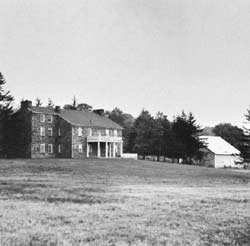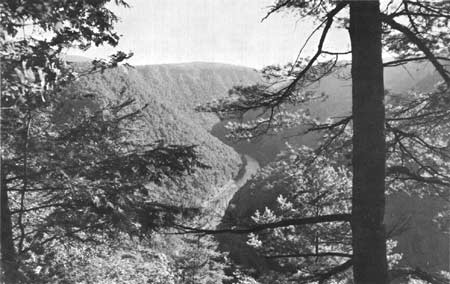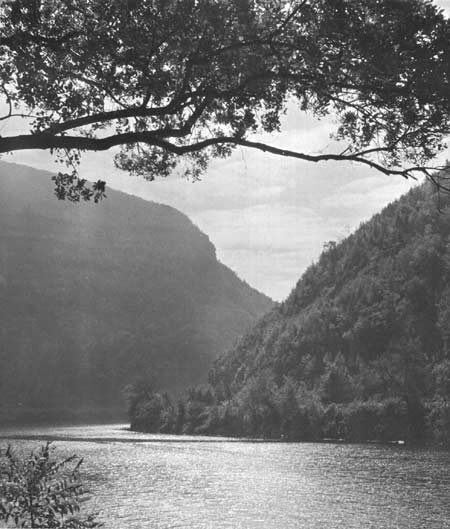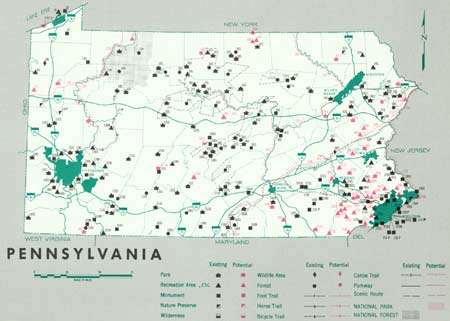.gif)
Parks for America
MENU
|
Parks for America
|

|
PENNSYLVANIA

|
| When the Allegheny Portage Railroad carried Pennsylvania Canal boats over the mountains, passengers stopped overnight at the Lemon House atop Allegheny Mountain. This area and parts of the railroad route are proposed as a national historic site. |
PENNSYLVANIA is generously endowed with outdoor recreation resources.
The State population increased over 821,000 between 1950 and 1960. The increase occurred primarily in suburbs of major cities. There are 12 metropolitan areas. With 71 percent of the population urban, the density ranges from 11 per square mile in Forest County to 15,768 in Philadelphia County. Projections indicate State population will increase from 11,319,366 in 1960 to 12,814,000 by 1976.
Agriculture, mining, and manufacturing are the primary industries. Tourist expenditures in the State were estimated at $1.5 billion in 1959.
The east-west "Shortway" will make the recreation resources in the north-central portion of the State more accessible for a large urban population.
The varied topography of Pennsylvania, ranging from flat tidal river shores to forest-clad mountains, the three major river systems, and the scattered lakes in the northwest and northeast regions constitute the State's principal recreation assets. Approximately 50 percent of the State is forested. The fall foliage colorations and the spring flowers are particularly appealing. Existing and proposed reservoirs, 2.3 million acres of National and State forests, and almost 1 million acres of State game lands offer important present and future public recreation opportunities. Semiwilderness and free-flowing streams are common, primarily in the north-central part of the State. Hunting and fishing are important recreation activities of State residents and out-of-State visitors. There is an excellent cooperative farmer-hunter program.
Pennsylvania has a wealth of historic sites, many of which have been preserved by State or Federal agencies. Fourteen sites not in the National Park System possess exceptional value in commemorating the history of the United States.
EXISTING PUBLIC AREAS
NATIONAL: The National Park Service administers four historic areas totaling 4,129 acres. The attendance in 1960 was 3,165,900. The Forest Service administers 1 national forest of 471,077 acres, with 10 recreation areas. Six reservoirs, with 4,203 surface acres of summer pool and 21,574 acres of land, are administered by the Corps of Engineers. The Bureau of Sport Fisheries and Wildlife administers one national wildlife refuge of 1,559 acres.
STATE: The Division of State Parks and State park commissions administer 92 areas totaling 204,311 acres. The 1960 attendance was 22,500,000. Fifteen State forests containing 1,870,783 acres are administered by the Division of State Forests. There are 49 picnic areas scattered through the forests. The Pennsylvania Historical and Museum Commission administers 20 historic areas, consisting of 699 acres. State game lands, comprising 216 tracts totaling 960,653 acres, are administered by the Game Commission. The Fish Commission administers over 100 areas (7,200 acres), including lakes, streams, and access points. There are over 50 roadside rest areas under the Highway Department, which has an expanded wayside program under way.
LOCAL: There are approximately 29 nonurban parks and recreation areas with 13,700 acres.
QUASI-PUBLIC AND PRIVATE: Major areas administered by quasi-public and private agencies include eight historic monuments, seven natural areas of 3,640 acres, and three trails 464 miles long.
PRIVATE ENTERPRISE: Important family-style vacation facilities are provided by private capital. Principal resort areas are located in the Pocono and Allegheny Mountain regions and the lake district in the northwest. Organized summer camps for children are also important.

|
| Pine Creek Gorge, Pa., a potential State park area of exceptional natural beauty. |
PARK AND RELATED NEEDS
The State park system is well established and reasonably well developed. Areas are somewhat unevenly distributed in relation to population, with a pronounced deficiency near major urban areas. A primary need is the expansion of metropolitan and other local nonurban park and recreation systems and facilities.
Existing nonurban park and recreation areas under State and local administration provide approximately 204,300 and 13,700 acres, respectively, for the State's 11,319,000 residents. There is a current need for some 305,000 additional acres in the State system and an estimated 112,600 acres in local parks. Potential areas identified in this plan total 114,482 acres of State significance and 27,423 acres of local significance. The potential State and local acreage, plus other acres, should be acquired to provide well-distributed and adequate State and local parks by 1976.
The figures above do not reflect the almost 3.3 million acres of National and State forests and fish and game lands which are largely available for recreation use.
Free-flowing streams and the associated natural and scientific features are valuable recreation resources requiring protection.
There is need for parkways and scenic roads. Additional boating facilities are needed on Lake Erie and on the inland waterways. Adequate land for recreation development is needed at existing and proposed reservoirs. There is a need and opportunity to supplement park systems by utilizing other public lands for general recreation purposes in addition to the primary purposes for which the areas were established. It is desirable to initiate and/or expand existing programs for public horse and foot trails, camping, nature preserves, waterways, and hunting and fishing access. There is need for a stepped-up program of waysides along existing roads and on the Interstate Highway System. Water pollution is a statewide problem needing further attention. While much has been done to preserve and present to the public the State's rich array of historic sites, this valuable resource is capable of further development.

|
| Pennsylvania and New Jersey meet spectacularly at the Delaware Water Gap, long renowned as a scenic attraction. The area would be included in the proposed Tocks Island National Recreation Area. |
RECOMMENDATIONS
Existing recreation resources and many potential areas are shown on the accompanying tabulation and map. Prompt action on the following recommendations by the agencies concerned is urged to help provide needed outdoor recreation opportunities for public enjoyment and use.
NATIONAL: Establishment of the recently authorized Tocks Island Reservoir as a national recreation area, of an Allegheny Portage Railroad National Historic Site, and of a Johnstown Flood National Memorial, and to determine if the Raystown Reservoir has potential as a national recreation area. Cooperative study of the possibility of an Appalachian Parkway; also an Ohio River-Allegheny River Parkway, portions of which would be in Pennsylvania.
STATE: Establishment of a long-range State land acquisition and development program to meet recreation needs.
Recommended—three park areas and major additions to six existing areas. Additional areas suggested—10 park areas.
Provision of adequate public recreation land and developments on existing water-control reservoirs. Consideration should be given to the construction of reservoirs primarily for recreation.
Recommended—14 areas. Additional areas suggested—seven.
Detailed cooperative study to determine the desirability and feasibility of parkways or scenic routes along the Susquehanna and Delaware Rivers. Studies should be initiated to determine the possibility of retaining selected streams in a free-flowing state.
LOCAL: Expansion of existing metropolitan, county, and other local park systems. Recommended—3 areas; additional areas suggested—10; major additions to 2 areas.
Supporting recommendations include—
1. Expansion of boat marina facilities on Lake Erie and on inland waterways.
2. Liberalization of restrictions on use of existing public fish and game lands, in favor of general recreation compatible with wildlife protection.
3. A comprehensive survey of archeological and historic sites within the State with a view to the preservation and development of those found to possess sound educational and inspirational values.
4. Expansion of existing systems of trails, nature preserves, and hunting and fishing access sites.
5. Wayside developments along the Interstate Highway System, keeping pace with highway construction, and expansion of the wayside program for existing roads.
6. A stepped-up statewide effort at all levels of government to reduce stream pollution.
7. Permanent easements for the Appalachian Trail.
8. Additional enabling legislation for county and metropolitan parks.
(Table omitted from online edition)

|
| (click on image for an enlargement in a new window) |
NEXT >>>
|
|
Last Modified: Mon, Sep 6 2004 10:00:00 pm PDT
parks_america/pennsylvania.htm
 Top
Top